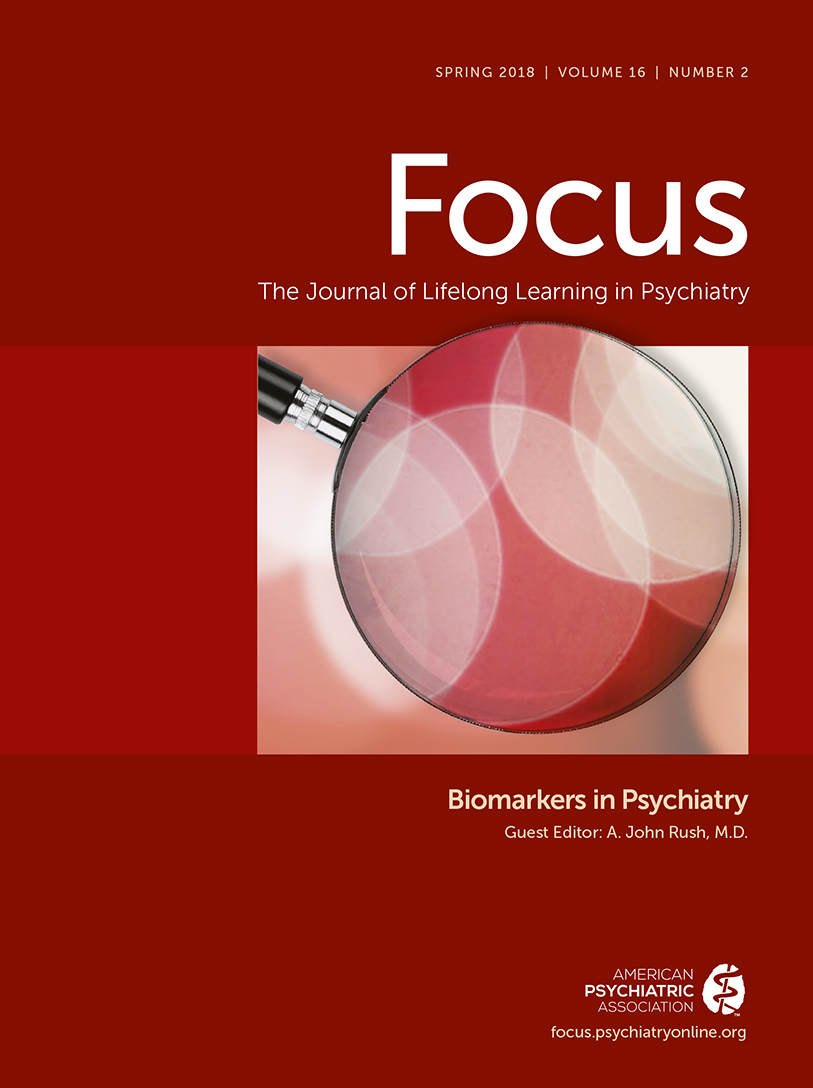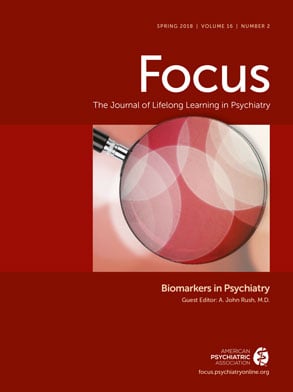This issue of
Focus provides an in-depth look into the opportunities, challenges, and complexities of the identification and application of biomarkers from both clinical and etiological perspectives. I and my colleague Hicham Ibrahim, M.D., provide a conceptual overview of what biomarkers are and what value they may bring to clinical practice and clinical decision making (
1). A series of articles then illustrate the status of biomarker research in diverse conditions such as autism spectrum disorder (
2), posttraumatic stress disorder (
3), schizophrenia (
4), and selected dementias (
5). Dr. Reynolds provides a case to illustrate how currently available biomarkers affect the care and clinical decision making of a person with sleep-wake disorder complaints (
6).
When the editor, Mark Rapaport, M.D., asked me to edit this volume, I was excited to do so because I believe that the future of psychiatry will entail the development and application of biomarkers in nearly every aspect of practice, including rendering a diagnosis and a differential diagnosis, selecting appropriate treatments, predicting and perhaps preventing adverse treatment effects, personalizing dose titration schedules as well as multistep treatment programs, and predicting—if not preventing—relapses. Biomarkers will help us measure disease progression and resolution, taking us far beyond symptom rating scales to gauge how we are helping patients. As we gain a deeper understanding of the pathobiology of our disorders, the use of biomarkers will enable us to identify and intervene with individuals at high risk for severe mental conditions such as schizophrenia or bipolar disorder even before the full syndrome appears clinically. These likely advances in biomarker methods (genomics, proteomics, metabolomics, imaging methods, etc.) and their clinical applications will come with new educational and ethical challenges. As clinicians, we, as well as our patients and their families, will need to become very comfortable with the language and conceptual understanding of statistical notions such as likelihoods, risk ratios, likelihood ratios, and probabilities. We must help our patients understand that very few biological or psychological tests are unerringly diagnostic or predictive of the course of the condition or a treatment outcome. My impression is that most patients seeking medical, surgical, or mental health services—even those who are highly educated—believe that care is more mathematical than statistical. The view is, the doctor asks a few key questions, does a few tests, gets the answer, and applies the right intervention. The assumption is that there is one right answer and that a great clinician will provide it. If the outcome is disappointing, however, the clinician is not so great, and a replacement is needed.
Reality is far more probabilistic than this utopian view, for several reasons. Evidence-based information is quite modest or even absent in many situations. Even well-developed and widely accepted laboratory tests entail true- and false-positive as well as true- and false-negative test results. These test features, and thus the overall test performance, depend substantially on the patient group in which the test is used. Consequently, clinical information from patients and families will remain essential to deciding whether and for whom to order one or another biomarker test in the future as well as how to interpret any test results—whether positive or negative—for both patients and their families.
As psychiatrists, we have been slow to adopt measurement-based approaches to diagnosis as well as treatment delivery, although this pattern is now changing. The future is sure to add to what we can and likely should measure. I hope that readers of this issue will become eager but discerning consumers of biomarker advances that are sure to occur over the next decade. These advances will demand greater clinical skill and a deeper understanding of the world of prediction and probability. May we all enjoy the journey.

